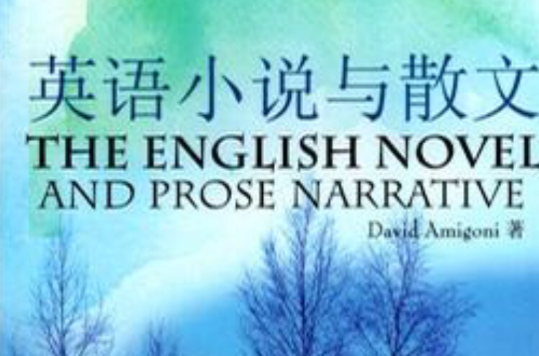《英語小說與散文》是2009年上海外語教育出版社出版的圖書,作者是(英國)阿米戈尼(Amigoni.D.)。
基本介紹
- 書名:英語小說與散文
- 作者:(英國)阿米戈尼 (Amigoni.D.)
- ISBN:7544611868, 9787544611862
- 頁數:172
- 出版社:上海外語教育出版社
- 出版時間:第1版 (2009年1月1日)
- 裝幀:平裝
- 開本:32
內容簡介,目錄,
內容簡介
《英語小說與散文》通過分析、解讀不同時期的英美文學作品,比較全面、系統地介紹了不同流派的英美小說與散文的起源、發展和演變;《英語小說與散文》同時也涉及相關的文學批評理論。“外教社原版文學入門叢書”以介紹文學理論和小說類型及相應的社會文化背景為主,勾勒出英美文學發展的概貌。
目錄
Acknowledgements
Preface: the scope of the book and how to read it
1 Introduction: straightforward discourse and novel transactions
1.1 Literature and non/literature?
1.2 Prose
1.3 Narrative
1.4 Narrative in context: the novel, mimesis and poetics
1.5 The novel and prose narrative in literary/critical argument: formalism and old and new historicisms
1.6 Studying the novel and prose narrative: historicism, culture and rhetoric
1.7 The novel and prose narrative: from 'literature' to 'intettextuality'
1.8 The novel and prose narrative as 'forms of discourse'
1.9 The novel and 'culture' revisited: 'cukure' as learning,'self, culture', 'culture' as a field of conflict
2 The elements of narrative analysis and the origins of the novel: reading Jane Austen's Emma and Samuel Richardson's Pamela
2.1 The novel and formalist criticism
2.2 Reading the form of narrative fiction: Jane Austen's Emma
2.3 Implied reader, real reader: narrator, implied author
2.4 Events: story and discourse
2.5 Character and point of view in Emma
2.6 Limitations of the formal approach: social spaces and voices in narrative, from free indirect speech to social contexts
2.7 What happens in Richardson's Pamela'.
2.8 First,person narration and the epistolary form:the dramatised narrator, rhetoric and the narratee
2.9 The narratee and writing as an 'event' in Pamela
2.10 Pamela, print culture and debates about genre: the familiar letter, criticism and 'the novel'
2.11 The debate about the origins of the novel
2.12 The rise of the novel: Ian Watt and the tradition of formal realism
2.13 Contested fields of cultural discourse and the rise of the novel: Lennard J. Davis and Michael McKeon
2.14 Gender and the rise of the novel: the domestic woman and the production of subjectivities
2.15 Re,reading Emma: letters, standards and intertextual allusion
3 Bildung and belonging: studying nineteenth.century narrative and 'self/culture'
3.1 The bildungsroman
3.2 Biography and autobiography in the nineteenth century
3.3 The viewpoint of youth: bildung in nineteenth,century history
3.4 Reading Jane Eyre: the critical reception; romance and 'self, culture'
3.5 Romantic autobiography and character classification in Jane Eyre
3.6 Space, time and subjectivity in Jane Eyre
3.7 Where does Jane Eyre belong.
3.8 Reading Samuel Bamford's Early Days: the common narrative strategies of autobiography and novel
3.9 'Reality is always romantic, though the romantic is not always real': the truth of autobiography
3.10 Reading Elizabeth Gaskell's The Life of Charlotte Bronte: the rhetoric of biography
3.11 Biography, gender and the public position of the woman writer: negotiating 'realism' and 'romance'
3.12 Reading George Eliot's The Mill on the Floss: culture as 'incarnate history'
3.13 'Writing the history of unfashionable families': the workings of Eliot's 'realism'
3.14 Testing 'self, culture': 'eddication' and the role of the reader in Eliot's realism
4 Innovative stories and distinctive readers
4.1 The art of prose narrative
4.2 Charles Dickens's Bleak House: reading the estranging poetry of prose
4.3 'Reading' in context: journalism and fiction
4.4 Nuggets for the masses: newspaper stories
4.5 Reading the 'sacred nugget': distinctive narrative art in James's The Spoils of Poynton and its 'Preface'
4.6 James's narration and the discriminating reader
4.7 Contesting 'The Future of the Novel': Henry James's 'delicate organism' and H. G. Wells's 'right to roam'
4.8 Reading H. G. Wells's Ann Veronica
4.9 The short story
4.10 Thomas Hardy's 'The Withered Arm': the epical tale
4.11 Katherine Mansfield's 'The Garden Party': the lyrical story
4.12 The experimental novel: reading for voice and consciousness in Virginia Woolf's Mrs Dalloway
4.13 Thenovelistic scope of Mrs Dalloway
4.14 Woolf's narrative experimentation in context
5 History, intertextuality and the carnivalised novel: postmodern conditions and postcolonial hybridities
5.1 Playful narratives
5.2 The novel as history, and the postmodern novel as metafiction
5.3 Midnight's Children as postmodern 'historiographic metafiction': sniffy incredulity towards metanarratives
5.4 The novel as national fiction: postcolonial concerns
5.5 The discourse of Midnight's Children in 'long' cross,cultural history: Laurence Sterne's Tristram Shandy as eighteenth,century metafiction
5.6 Bakhtin's 'carnivalised' narrative: a 'second line of development' for the novel
5.7 Camivalised narrative, postcolonialism and the debate about 'hybridity': Midnight's Children revisked
5.8 Conclusion: long live postcolonial realism, the bildungsroman and leakage
Select bibliography and suggested further reading Index

